
Specs
- Frequency response: 15 – 40kHz
- Sensitivity: 112 dB/mW
- Impedance: 19-ohm
- Weight: 8g per earpiece / 42g including cable
Packaging


FiiO really have outdone themselves with this one. Not only does the FH5 has the nicest, most professional and premium-looking packaging that I’ve ever seen from them, but this is also some of the nicest packaging I’ve ever experienced, period.
The outer-sleeve doesn’t look like anything particularly interesting, and actually is remarkably understated. But, once you remove that sleeve and get to the main box, that’s when things change.
The lid lifts up like a hardback book, and what we are presented with first is the FH5 in all its glory. When I say this is a presentation, that’s exactly what I mean. The product, along with the manufacturer’s pride, is on the display.
I’ve said it many times, and I still believe it to be true; a product’s packaging says a lot to me about how the manufacturer feels about their creation. If the packaging is a bit skimpy, then it makes me wonder what they skimped on with the actual product, and then vice versa for when we get really nice packaging. If there is a high-level of care and attention to detail that went into the box, then that leads me to believe that they invested at least the same amount of time and energy into the creation of the product.
Of course, that’s not an objective view at all, as in reality there is absolutely no direct link between product quality and the packaging quality. But still, I’m not going to complain about getting a nice presentation.
Whilst the FH5 sits proudly surrounded by the top layer of foam, there is a pull-tab that allows you to lift this foam layer in order to remove the IEMs and the cable. But, underneath lies some more goodies.
What’s in the Box
- FiiO FH5
- 9x Pairs of silicone eartips
- 3x Pairs of Memory foam eartips
- 1x Soft carrying/storage pouch
- 1x Hard carrying/storage case
- Cleaning brush
- User Guide
- Warranty booklet
Accessories
We get a total of 12 eartips which range in both design and size. There are 4 types, and 3 sizes for each type, namely small, medium, and large.
The first set are the Balanced eartips, which are presumably intended to give the most balanced frequency response.
Next up are the Vocal eartips, which (again, judging from the namesake) will probably elevate the midrange slightly.
The last bunch of silicone tips are the Bass tips, which would work to either elevate the bass region slightly, or suppress the upper registers a bit.
And then we get to the final 3 pairs of eartips which are made of a memory-foam type of material.

With FiiO’s previous IEMs we either got a hard carrying case (the HB1, which is also sold separately), or a smaller soft carrying case. However, with the FH5, we are not only getting both a hard and soft storage solution, but the hard case is also of a brand new design for FiiO.
Ok, essentially it’s the same as the HB1, but instead of the gloss black plastic of the HB1 this new case is made of clear plastic. But the rest of the design and function seems to be identical, which should mean that it’ll have the same protection and waterproof standards of the original HB1.
Design


The design of the FH5 is, overall, totally new for FiiO. The shape and other aesthetic elements are unlike what they’ve done before, although the finishing seems to be either identical or at least very similar to that of the F9-series.
What we’re seeing here is a design, fit and finish that just oozes quality. The faceplate lines up almost perfectly with the main IEM body and there are only a few very minor imperfections to speak of if you really look for them.
There are 2 very interesting visual elements here, both of which are found on the faceplate. First up is a thin gold-plated edge. Generally I’m not a fan of gold plating, but in this instance I think it works exceptionally well. It’s not an over-the-top addition to the design, and perhaps by using, what seems to be 10 carat gold, this detail is noticeable, yet still understated. Then there is this rather odd corrugated design which FiiO states that this design was inspired by the streamline vehicles of the early 20th century. To me it kinda looks like a t-shirt being stretched. Again, it’s not an over-the-top and in-your-face design-element, but it adds just the right amount of flair.

Weighing in at roughly 8g per earpiece (double that of the F9 and a little more than the Pinnacle P1), the FH5 can, seem a little weighty when compared to the majority of IEMs out there.
Perhaps that seemingly added weight is in part what gives the FH5 this perceived level of build quality, but of course any added weight with IEMs also raises the concern of how it would affect the comfort.
But, I’m happy to report that FiiO did a great job here with the design of the housing and indeed of the cable too. The overall shape works incredibly well in terms of ergonomics, and the smooth matte/satin finish definitely helps in this department. Of course I can’t speak for everyone or even most people as people’s anatomy differs, but I can confidently say that the FH5 is one of the most comfortable IEMs I’ve ever tried. Again, due to the shape, the finish, and the way the cable nicely balances the weight, these are IEMs that I can easily wear for long periods of time. And speaking of the cable, the one included here is also one of the nicest I’ve ever come across. It’s perhaps ever so slightly on the stiff and heavy side, but only just a bit. It feels incredibly well constructed and designed, and I particularly like how the left and right channels are separated for the entire length of the cable.
At each of the MMCX connectors there’s also a coloured collar to differentiate between the left and right channels. Red is for right, and blue is for left. Being able to easily distinguish which is which is great, but FiiO took this one step further and did something similar on the actual housing of the IEMs too.
If we look at where the cable connects to the housing, both the left and right earpieces have corresponding coloured parts.
When taking a step back and looking at the design of the FH5 in its entirety, I think it’s fair to say that this design seems incredibly refined in terms of the build, comfort, and aesthetics. Not only is the FH5 FiiO’s current flagship, but it’s also what I would consider to be an honest flagship design and, to me, it sits right up there with competing products that cost many hundreds of dollars more.
One major advantage of the FH5 is how power efficient it is. With an impedance of just 19-ohm and a sensitivity of 112dB/Mw, you really don’t need much power to blow out your eardrums. One of the most common criticisms of FiiO’s M7 portable player is that the 40mW of available power is quite low, especially when considering more power-hungry headphones or IEMs like the 50-ohm Pinnacle P1. But, for the FH5 that 40mW is more than enough.
Sound

Since FiiO introduced their first set of IEMs a few short years ago, they’ve been making some very steady improvement to both the design and sound of their products. However, in the case of the FH5, what we are seeing here is more of a refinement in sound, rather than a leap forward.
Before the FH5, FiiO’s latest IEMs were the FH1, and I rather liked them, especially considering their price-point. No, they’re not perfect, but compared to the F9 and F9 Pro the FH1 had a much more pleasing signature to me and had a sound that I could listen to for extended periods of time. The F9-series, on the other hand, sounded much brighter in comparison, and as a result I perceive them to sound quite artificial. The problem there as a very large treble spike at around the 8 or 9kHz mark which introduced a lot of piercing highs. With a little bit of EQ work the F9 actually could sound quite balanced and overall pretty darn good. But I think it’s safe to say that most people would rather just plug in a set of headphones or IEMs into their device without having to worry about fiddling with any sort of EQ, and this is especially true if you use multiple devices.
So, when the FH1 came around it offered a presentation that was quite different to the F9. It had more presence in the bass regions, but more important was that it addressed that sharp treble spike. Now, unfortunately I couldn’t do a measurement or recording of the FH1 as I only got my testing rig more recently, but for what it’s worth, the FH5 sounds rather similar to what I remember the FH1 to sound like but with perhaps an overall slightly smoother character. But again, that’s entirely going off of memory, so take that with a pinch of salt.
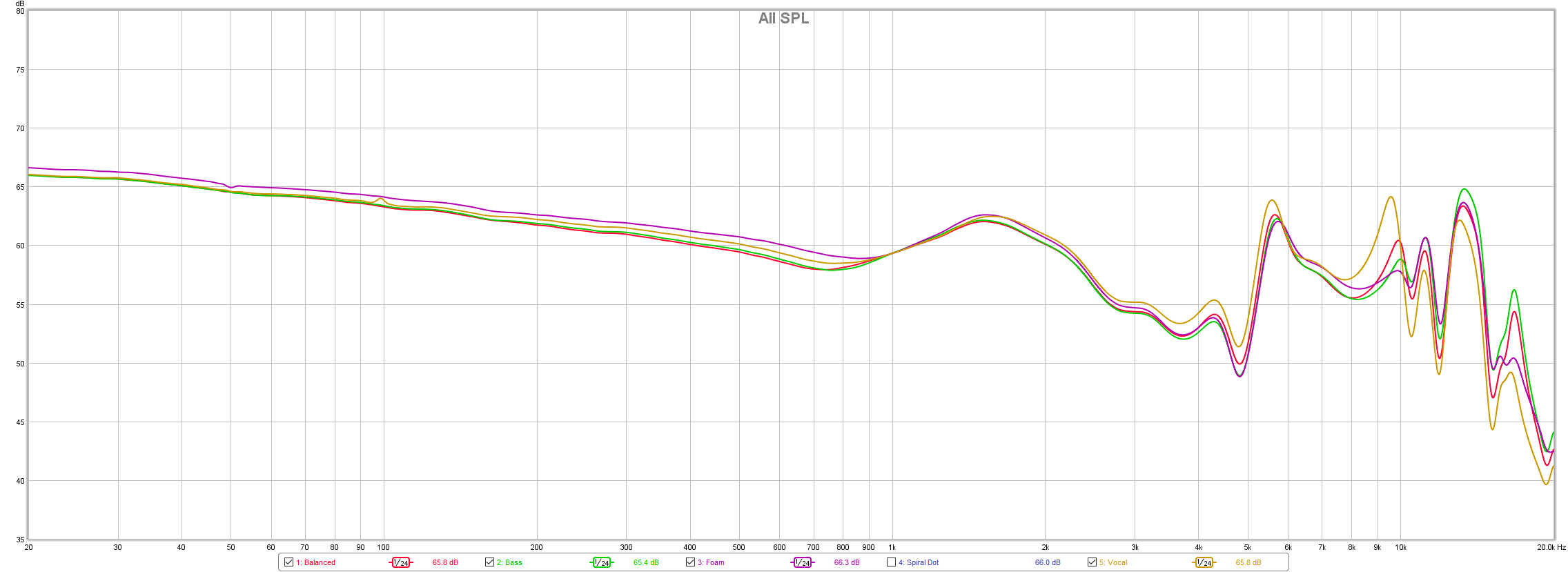

As FiiO includes a number of different eartip designs, let’s take a look at how they alter the sound character of the FH1.
Overall, despite being labelled to favour different sound signatures, we’re not seeing any major changes in frequency response between the different tips except when looking at the bass and midrange with regards to the memory foam tips and then in the high frequencies with regards to the vocal tips. That sharp treble spike produced by the vocal tips can indeed ad a bit more sparkle and presence but this area also tends to be very troublesome as any sharp spikes here is what introduces piercing sharpness. As we can see from the graph, there are some spike here with the included tips, but when using the JVC Spiral Dot tips this issue is avoided altogether.
Speaking of the Spiral Dot tips, these are my tips of choice when making measurements and also tend to be my go to tips when listening to any IEMs. This is simply because they are super comfy, but more important is that they give me the most reliable and most consistent results when making measurements and recordings. The added benefit to using the same tips for all measurements and recordings also means that when we compare the sound of IEMs to one another we don’t have to account for the difference that would also be brought in if using a wide range of different tips as well. However, it’s still very important to experiment and try out different tips to see which you like best. It’s very easy to assume that a particular type of eartips would always affect all IEMs in a predictable way, but that simply isn’t the case.
So, that being said, with reference to using the Spiral Dot tips on the FH5 I’d say that these tips unfortunately do more harm than good as far as the sound signature is concerned. It’s a real pity, because these eartips are so comfy, but the fact is that the FH5 already has those recessed upper mids, and the Spiral Dot tips simply reduces this range even further. If I had to pick a winner, I’d say the balanced tips seems the best…errrm…well, balanced of the bunch, whereas the vocal tips do add a little bit of sparkle up top. The foam tips also bring those upper mids up from where the are when using the Spiral Dot tips and at the same time they also have the smallest peak at around that 9kHz point.
So, for the comparisons with other IEMs, we’ll be looking at the average response of the included eartips and excluding the Spiral Dot eartips completely.
Comparisons
FH5 vs F9
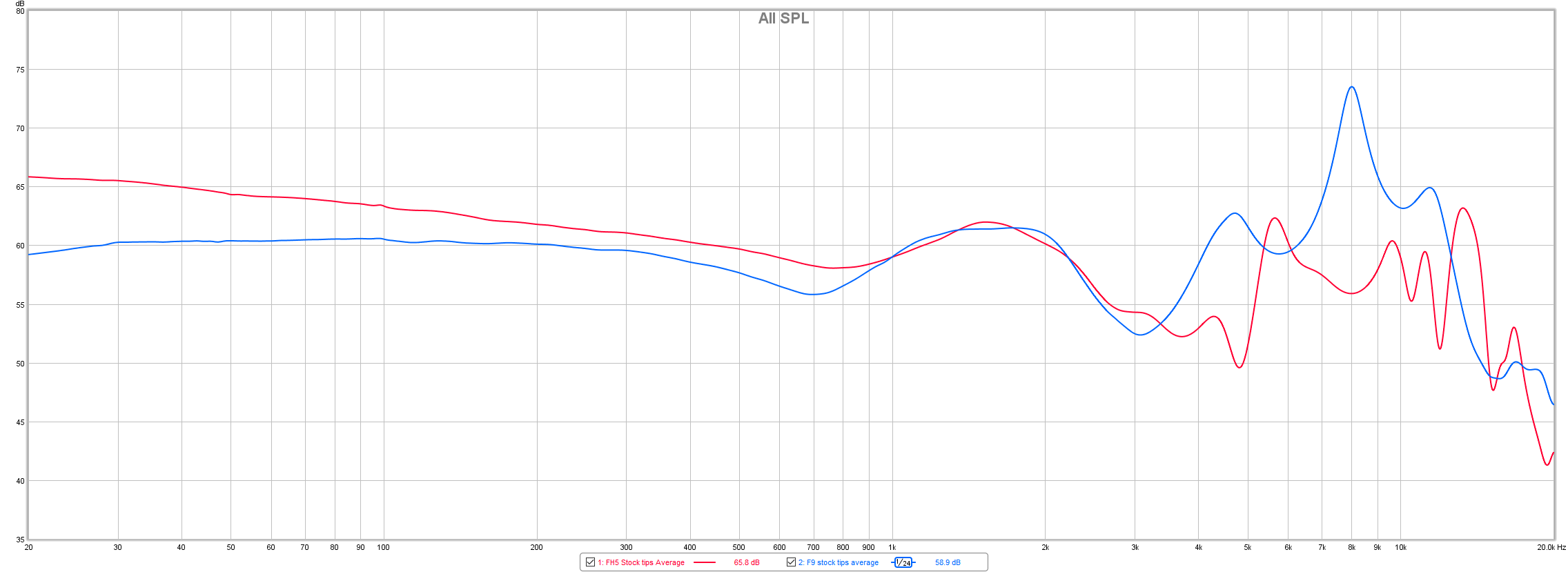
The first difference we can see is a bass boost for the FH5 in the sub-bass area, and it continues to have elevated levels all the way up to the 1kHz mark. Overall The F9 has more balance in this area.
Moving on towards the midrange, here we again see a similar character, although the F9 carries this region over a slightly wider range in the vocal department before it drops off again.Other differences are seen between about 3kHz and 6Khz, with the F9 portraying a bit more presence here which we can hear in how male vocals are presented.
However, if we look at the 8-10kHz region we can see a huge difference between the FH5 and F9. The F9 has a very large treble spike, and as a result sounds quite piercing. On the flip side, the FH5 greatly reduces the chances of that happening, but at the same time it also means that there can be a lack of air in vocals as well as a reduction in that lovely shimmering effect of cymbals. But, overall, the FH5 has the more balanced and natural-sounding signature, something totally different to the artificial-sounding treble of the F9.
FH5 vs Pinnacle P1
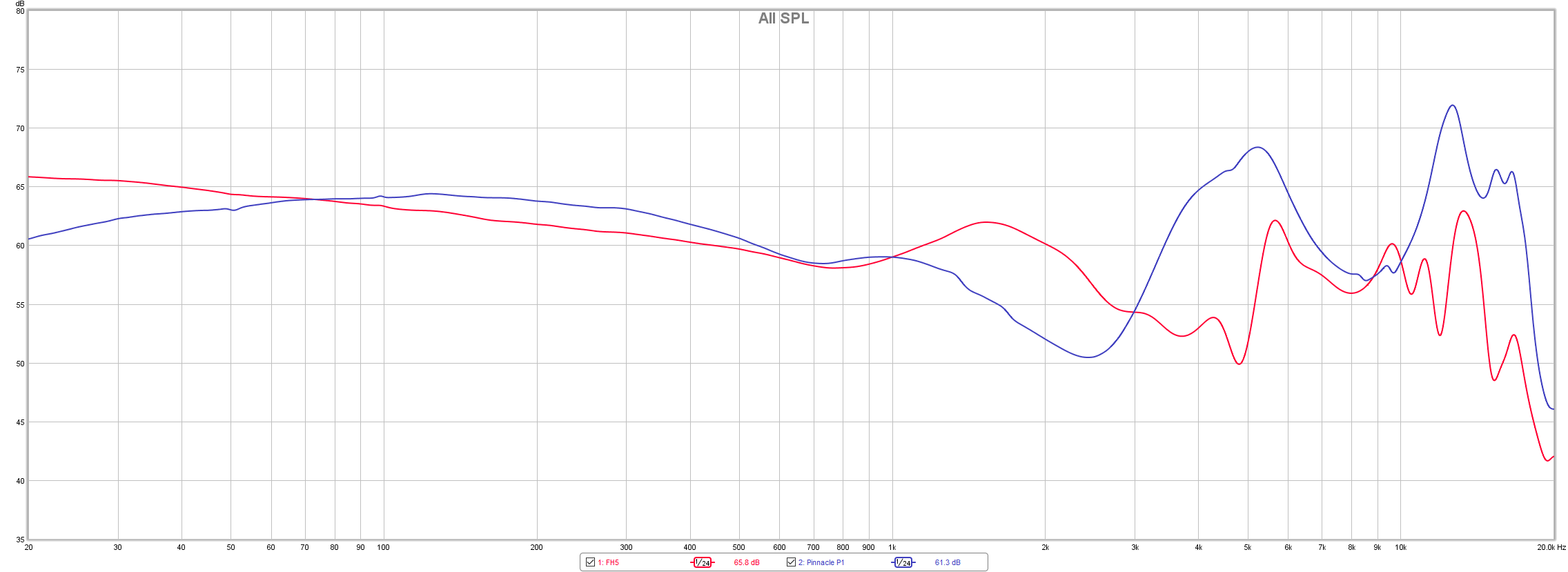
The Pinnacle P1 from MEE Audio is quite a little gem. It really does have one of the best signatures out there, and for myself it’s my personal favourite set of IEMs at the $200 mark.
It might not have the sub-bass extension that the FH5 has, but overall it has more balance and cohesion in the bass region and lower midrange. However, if we look at the graph of the high mids, that’s where we see quite a big difference in presentation. Where the FH5 lacks presence and attack, the Pinnacle P1 gives you much more of it. As a result, the P1 tends to have more of a full and natural sound.
Then if we consider that 8-10kHz region again we see that the P1 is very well-behaved here offering no sharp spikes that would be otherwise problematic.
And finally, when we look beyond 10kHz we again see more presence from the P1, and it’s these spikes that are responsible for the wonderful shimmery portrayal of cymbals form the P1.
FH5 vs DK-3001
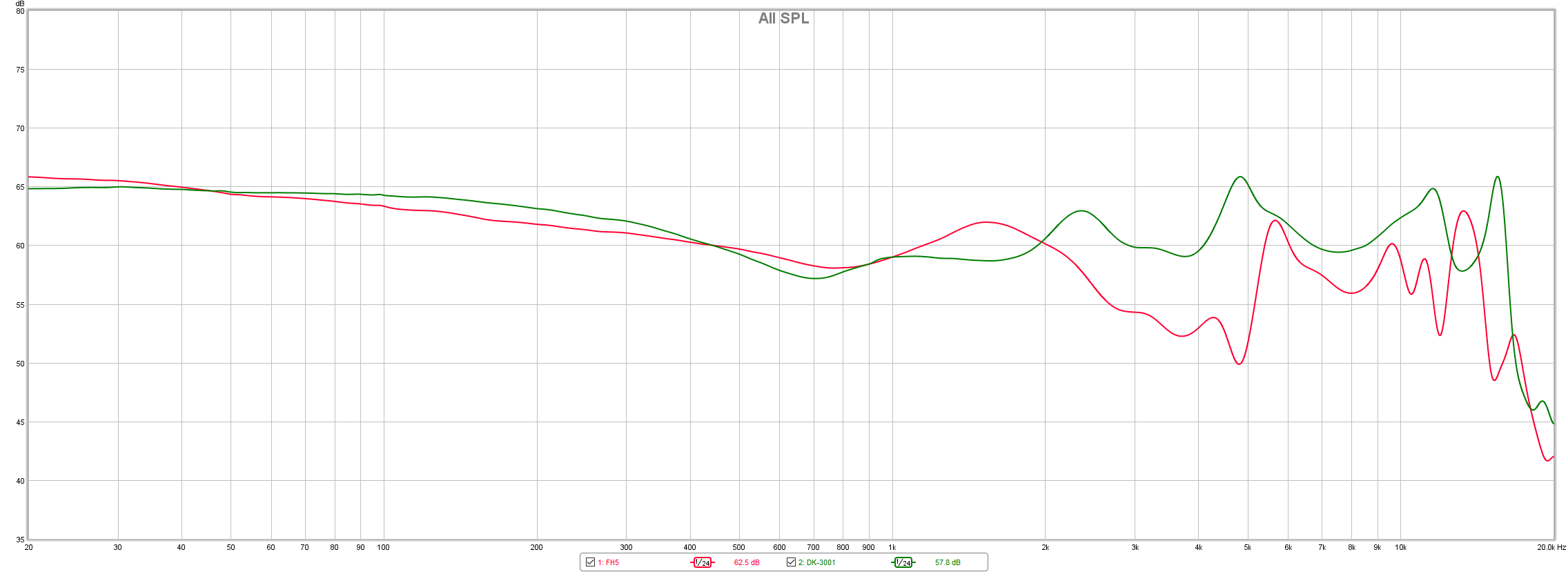
OK, yes, the DK-3001 from Dunu does cost double what the FH5 does, but when we’re talking about really good sound signatures, then the DK-3001 is a really good example to use.
If we look at the sub-bass and bass region, the Dunu has just about the same amount of sub-bass extension as the FH5, but also slightly more fullness for the rest of the bass notes. Again, when we get to the upper mids we’re seeing much more presence from the Dunu and an overall more energetic sound signature. Past 10kHz there are some differences which gives the Dunu a bit more sparkle here and there, but nothing too major.
Overall, we’re seeing a more neutral and balanced character from the DK-3001, as opposed to the slightly warmer and noticeably darker sound signature of the FH5.
However, if I absolutely had to pick between these 2, I’d definitely go for the FH5 simply because the DK-3001 is one of the most uncomfortable IEMs I’ve ever used in extended listening sessions. You don’t really pick up on this in the first few minutes, but after a while the incredibly unergonomic shape of the Dunu just makes it impossible for me to wear for any length of time of more than about 45 minutes or so.
Value
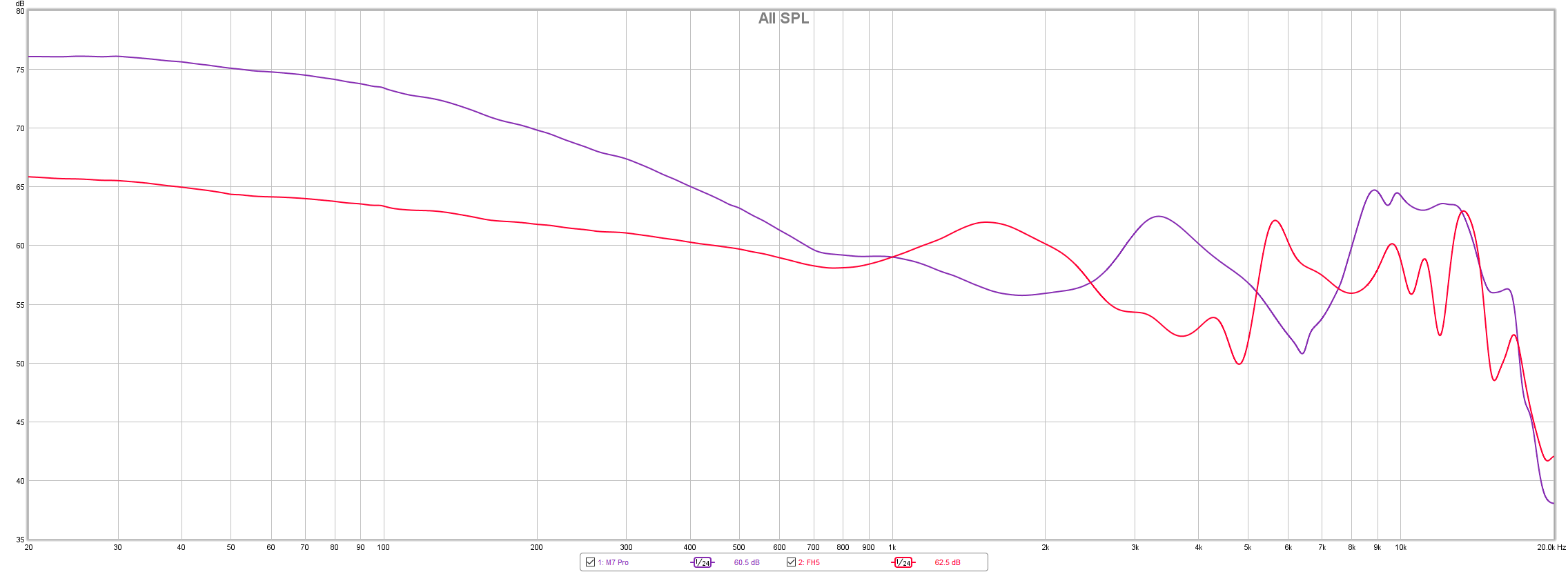
So, overall, where does the FH5 stand in terms of FiiO’s lineup. Well, sonically it’s not perfect, but I’m quite confident in saying that it’s their best IEM to date. I think the build quality alone is worthy of a price-tag higher than $250, and the refinement in sound character over the FH1 is a very welcomed addition.
But, when we consider the sound quality and compare it to other products, then we’re starting to see a compromise emerge.
Like the FH1, the FH5 is more catered towards bass-heads. I wouldn’t call it an overly-bassy sound like we got from the MEE Audio M7 Pro, but that darker sound and extended sub-bass does show more favour towards sub-bass-heavy tracks. For any music that has a particular emphasis on vocals, then that dip in the upper mids does come at a cost.
Of course, if you don’t mind messing around with EQ’s then you really can get the FH5 to sound pretty darn good. In fact, I’d wager that, with enough tweaking in the EQ, you could probably get the FH5 to sound somewhat similar to the DK-3001. Perhaps not quite the same, but close enough.
Feel free to use the above graphs as a reference for where you might want to make a few boosts or cuts if you do choose to buy the FH5.
When all is said and done, despite those sonic flaws, I still think FiiO did a reasonably good job here, and if you prefer a darker signature, then the FH5 could very well work out quite well for you.
While I personally don’t think it carries the outright sound quality that you get from something like the Pinnacle P1, I’m still very excited to see what FiiO comes up with for their future models.


